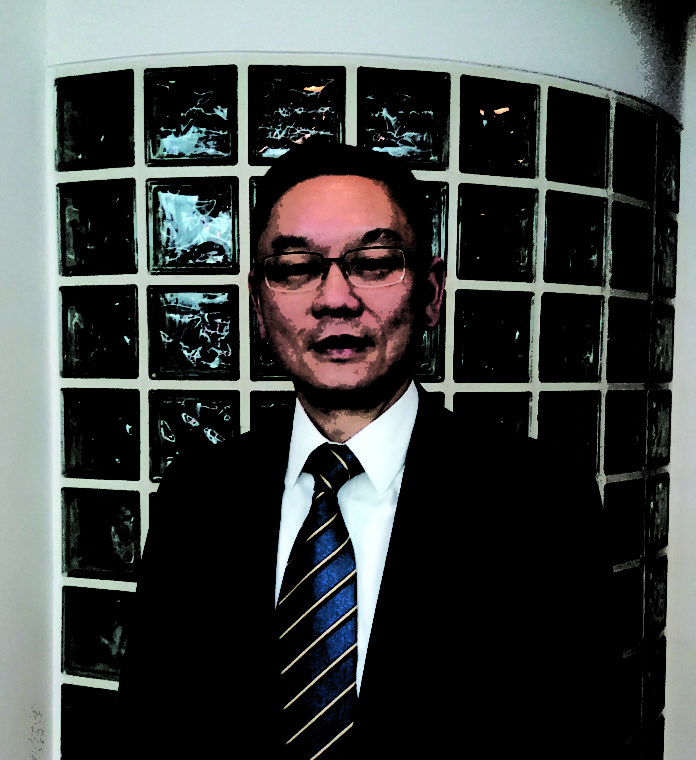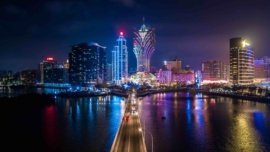San Ma Lou has already been subject to several studies and proposals of urban intervention, but continues to decay. Considering its history, and past and present planning projects, how do you evaluate the current state of the street?
Chui Sai Peng – I think it is one of the most important streets of Macau, in the past, now, and for the future. It is the shortest cut to link up the city’s central area to the Inner Harbour, the only thoroughfare to go from one end to the other, directly. It is almost an irreplaceable street.
Back in the past, because of the traditional location of Leal Senado Square, and its history it was the heart of Macau’s politics for a long time. It also has very important buildings: the Post Office, the Municipal Council (IACM), one of the oldest charity organisations, the Misericórdia, and now a major shopping area nearby. And because from the Square you can link up to the Ruins of Saint Paul’s, that has become a major tourist attraction.
For those reasons, it is a ‘must-go’ street for tourists, but it is not a ‘must-go’ street for citizens, who would wisely avoid going there in the peak time of the week or season. And yet, if you look at it in more detail you can divide the street into two parts. In its southern part, near Leal Senado Square, towards the Lisboa [hotel] side, it is very crowded, jam-packed. But if you go from Tai Fung Bank building down to Ponte 16, it is almost non-existent.
While one half of the street is very crowded, the other half is almost not crowded at all. And that’s why you see many ‘for sale’ and ‘for rent’ signs. When there’s no business, no foot traffic, nobody goes there. Now, on the very same street, both sides of the story are there. It’s an interesting fact that it is not in demand and that it is in demand. This is, in a nutshell, the situation of Macau, a microcosm of the city. Some parts are extremely busy, some parts are very much like in the 1950s: leisurely time, taking it easy, walking around slowly, and nobody bothers you.
San Ma Lou used to be a central street in Macau, for business and social life, but not anymore. Why is that?
C.S.P. – The whole street used to be very busy, but after the Inner Harbour changed to Porto Exterior in the early 1970s it changed at about the same time. That’s why one of the most interesting hotels – ‘Gwok Zai’ [Grand Hotel] – is now closed. This is unfortunate. How could a busy street have a derelict building like that? Because that end is not busy, that’s all.
You wouldn’t have that happen near the Post Office. Now, you have the opposite of this with the old, ‘Ping Ngon’ [Apollo Theatre]. From a theatre it changed into a commercial establishment. But it is still very well used, very nicely kept. There is no controversy. The owners are happy with the return of rent and shoppers are happy to have a place to go to.
But down at the other end it’s almost impossible to think of anything being there because it’s a very quite area. With the closure of Gwok Zai, even fewer people go there now. If you want to study anything in the city, in any city, this would be one of the most classic studies for an urban planner to do.
But there are people living in those neighbourhoods, people working in the stores which are still open. What could be done to improve life in a street which is also a heritage-protected one?
C.S.P. – There is an urban plan for Almeida Ribeiro (see Figure 1) available for a while now. The pink area that I highlighted for you indicates the development restrictions. Of all the recommendations, I think the most important ones are the few guidelines that say that in this whole place, the highest you can built is 20.5 metres, which is a Class M building, and the Heritage Preservation Act.
The value of redevelopment is probably not attractive enough for the owners to really do substantial development. I think the estimated price is way too high for any developer to accept. And maybe the people who have inherited the buildings believe that they’re worth a lot more than the developer can afford. So, nothing happens, even though the urban planning office has very good intentions of preserving the street.
As for me, I personally believe that preserving one whole street is much better than preserving just one building. It is so out of place and it doesn’t go with the harmony of the streetscape. This whole section of preservation, I believe, is a very effective way of preserving a certain period of time. Now, whether the whole street should be done, or part of it, I think, is up for people to discuss.
Multiple ownership and consensus,
an impasse for redevelopment
Is there a ‘solution’ for Almeida Ribeiro?
C.S.P. – You do have some [people] who have already shown their intentions, but you still have major challenges there. What I think is really affecting people’s decision is the mandate of heirs representing ownership agreement. According to our inheritance law, the children of the deceased parents have a right to it [the property]. This becomes a very interesting situation because as time goes by ownership is just passed on as inheritance, and after a few generations it’s almost impossible to keep track of who really owns it because it is not a ‘one-owner’ [property] – it’s a ‘family-owned’ [property] and that family is so big.
So, again, I think it is very important for us to consider that if we want to rehabilitate these buildings, ownership becomes a hindrance. But on the one hand it should be well respected because every owner should have his or her rights protected. On the other hand, because of the inability to unite all ownership consents it cannot move forward. Now this becomes a very big impasse for anyone trying to resolve that case.
It is urgent that we look at the ownership issue and find a consensus so that it can be moved forward. The current Almeida Ribeiro plan can be reviewed to see what better ways we can encourage the revitalisation of these derelict buildings, because they are falling apart. It is becoming a public safety hazard. And so it is time for us to look at it closely and practically, and find solutions that can actually give it a second chance.
Are you working on this particular part of Macau?
C.S.P. – No, the government has its own plan. I did some proposal to the government in the past, saying that perhaps we could make a pedestrian block-way system to link up the street and then all the way up to [the Ruins of] Saint Paul’s. To broaden the width of the street what I proposed in the past was very simple. Right now, we have three lanes, two lanes up this way, one lane down that way. The big problem we have is the width of the pedestrian [pavement], which is 1.5 metres or so. It’s too narrow.
What I proposed was – the road lane being about three metres each – if I create an interesting canopy [on both sides] I can widen each walkway by one and a half metres, and still have two road lanes left. It is less for the traffic, but more for the people. Now, this concept can be enlarged to what is already happening in front of Leal Senado Building, where the pedestrian walkway is twice or three times larger than a normal one would be. Why? Because by making it wider, we can move people faster. You want people here; you can have a little canopy so they can actually walk in rain and sunshine, and still be protected, so people don’t feel unwilling to walk.
At the same time, it would probably not solve the vehicle traffic problem. What would be the alternative? Re-direct traffic to other parts of town?
C.S.P. – Not a complete one, but if you widen the street of the pedestrian way you make the crowd less prominent and alleviate the situation. Alleviation is always one of the strategies to solving the problem. On the other hand, to consider the whole situation would probably be the time to review all the traffic systems around Avenida Almeida Ribeiro and perhaps we could find a way.
I don’t have the solution now because I’m not studying it. But you do have to think about it. When this was built in the 1920s, two lanes were more than enough, so three lanes is a luxury. So what do you do now? Should we preserve one side of the street and make the other side of the street wider? We have to think of different solutions, different schemes, and we have to study it responsibly, socially, historically, and also for the future. We have to find a solution that can meet all demands in the best combination. We have to find an optimal solution – but it’s not obvious now, unfortunately.
Pedestrian solutions:
No pollution, healthy and free
Was your study a formal proposal to the government? What happened to it?
C.S.P. – It was a formal proposal for the entire of Macau, to work on ‘pedestrianization.’ We were the very early advocates of making Macau more ‘walkable.’ So we conducted a study for the government back in 2005, I believe, and gave it to them, and in there we made some suggestions.
Of course, the government did not decide what it wanted to do with it. But after so many changes of directors, and Secretaries, I don’t know what’s happened to it. The truth is we made a proposal and hopefully somebody will look at it and some day it will come back to light. And if they have any respect for intellectual property, I hope they’ll give it back to me to let me finish my work. I still believe we put too much emphasis on buses, taxis and private cars. Macau used to be very walkable and I was proposing that maybe we should make the city walkable again.
What about using non-pollutant energy for public transportation?
C.S.P. – Well, walking is very non-pollutant, very healthy. You have to go to the gym to exercise, but you can do it on the street free, without charge; you can meet people, natural air, so you don’t even need artificial light, or air-con, and it’s free – so far! So you cannot be more economical than that. That’s another [benefit] I would say, something more people should reconsider.
Is it possible to close the whole street? Perhaps by creating a tunnel to channel cars out of the road?
C.S.P. – I think we have to look at it carefully. I would not say that everything could be done. But if you can find alternative solutions, or evaluate how much emphasis we can put on underground space usage, checking how open everybody is to ideas, I think that [with] all the possibilities evaluated some solutions are always possible.
As for the tunnel, again, we have to look at it. You can have a sky-train or a cable-car, if you want to make it into something very interesting, just a wild thought, like the ones they have at Wynn Palace. That you can do. And at the same time you are so high above that you can take photos, and you can also make it a little less crowded in the street because now you have people up in the sky. They come here, take some photos, this is a perfect view. So, many, many things are possible. But you have to look at it in a careful manner to see which one, or what combination, would produce a better result to make everybody or as many people as happy as possible.
Urban planning and public consultation not always a match
When you did your study, did you contact shopkeepers and people working in the street, for instance, to collect opinions on the project?
C.S.P. – Absolutely. We talked to people, but I think that sometimes talking to more people doesn’t always give you more insight. Rather, it might give you more limitations. When in a conceptual stage, with our background, because I was born here, raised here, and, of course, the people in my team, we talk to people, but is it a formal consultation?
I’m sorry.
If we have to do everything so formally, you can never move anything forward. The best way to kill a project is to do consultation, again and again. I don’t think the government do fake consultations but rather they listen too much. They listen for too long, and the decision cannot be made. And before a decision is made people are already criticising it for being too slow; and so, what are you going to do? I think that for the concept ideas you cannot just purely rely upon some people’s opinions, because you never hear enough from the people.
We have 600,000 people. How many is enough? It is always not enough. There is always one opinion you forget to ask. Different people will have different responses, different abilities, different knowledge of developing a project, and that’s why I always emphasise that for Macau’s urban renewal Macau local citizens should be involved when it is important – but also the planners themselves, for the locals, are
very important.
You’re saying residents should trust experts to take decisions or draft proposals for projects?
C.S.P. – What I’m saying is that they should have more confidence. Whether they win total trust, it is for every different person to win this. But there is a raft of people who state what they want, and where people will give you or produce a thing that is supposed to address a need.
And everybody will have their own interests (at heart). Take an example: where do you put the garbage can? Now, you take the discussion to everybody. You talk to everybody on the street, every single person there who has a storefront, and all of them agree that they need a garbage can. And there is another consensus – “not in front of my store.” OK, what do you do? . . . It will reach some point in which the professional has to exercise discretion.
So it’s a ‘no-solution’ discussion because everybody will have different opinions most of the time . . .
C.S.P. – Interests are diverse. Let’s face it. There is no one unified interest. Unified interests are for the good of society, but when you go into detail, the elite ask the people, and they always represent certain aspects, and so you have to find and trust a person who will have to eventually make a decision.
For instance, a permanent change that was made to Macau and that has now become consensus was the pedestrianisation of Leal Senado Square, the source of the beginning of our discussion. Now, when Governor Rocha Vieira decided to close that area there was a big upheaval within the Macau community. At that time, most people were against it, or had reservations or concerns.
But with his personality and conviction, he moved ahead. Twenty years later, there is not a single person, I think, who would say he was wrong. He would get a hundred per cent support vote for this project, twenty years after implementation, but not on the day of implementation. That is urban planning. Urban planning is not a collection of people’s ideas, but the work of somebody who has to look at the current affairs, with respect to the past, and a view of the future.
What is the problem, then?
C.S.P. – The problem is that the government does not make that a profession for us! I have been calling [upon] the government to make it like other bidders. You know, the bidders, they say, “Well, we have 20 million patacas for the construction of the hospital, 300 hundred million patacas for the LRT.” Do we have 20,000 dollars for urban planning? I don’t see it. It doesn’t look very significant because it is not very expensive, but it is very important because all the expensive projects are dependent upon planning.
Unfortunately, we have been overlooking the planning and jumping directly to the project. It is like not seeing the wood for the trees. We embrace the tree and find it is the best tree. True, it is the best tree – but put it in the wrong forest and it might not work very well.
BIO
José Chui Sai Peng
57 years old
Government service
Deputy of the Macau SAR to the 12th National People’s Congress (NPC)
Deputy of Legislative Assembly of the Macau SAR
Professional experience
President of CAA City Planning and Engineering Consultants Ltd.
Chairman of Macau Urban Planning Institute
Academic Background
Ph.D. in City Planning, Faculty of Architecture, Tsinghua University, China
Master of Civil Engineer, University of California, Berkeley, USA
Bachelor of Civil Engineer, Washington State University, USA
























